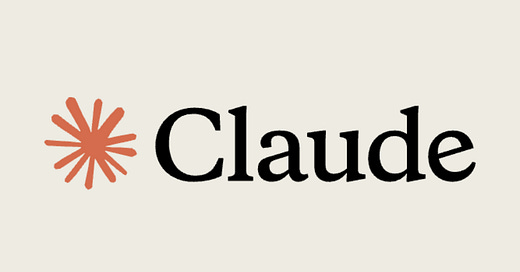AI Tool: Claude
Level: Beginner
Access: Free
This guide is part 1 of the free course Learn how to use Claude.
In this guide, we will cover:
What is Claude?
What is AI and Generative AI?
How was Claude created?
What can you use Claude for?
What is Claude
Claude is an AI tool created by the French AI startup company Anthropic.
It's a tool that can understand and generate text in a way that can be similar to the human level of understanding & quality for many tasks.
Claude is the same type of tool as ChatGPT, Microsoft Copilot, and Google Gemini.
The main way to use Claude is through a web page chat interface where you ask it questions or make requests, and it generates a text response.
While Claude can't do everything a human can do, for specific tasks, it can produce high quality and intelligent responses.
Claude and other similar AI tools can do this because they are based on a new AI technology called Generative AI.
What is AI and Generative AI
So what is AI? One of the best and simplest definitions was by AI pioneer John McCarthy who said:
AI is the science and engineering of creating intelligent machines
AI is used in many areas of life, some of which you may not have even realised such as:
Medical imaging: Eg to detect cancer from chest X-rays
Web search: Google, Bing etc
Fraud detection
Recommendations: Eg on Amazon, Netflix, Spotify when they recommend a product/movie/song to you
So what is Generative AI?
This new type of AI technology was only developed in the last few years. Former head of Google AI and AI Pioneer Andrew Ng has one of the best definitions:
Generative AI is an AI system that can produce high-quality content such as text, images and more.
While some of the most well-known examples of Generative AI include tools like ChatGPT and Claude, it's being used for a much wider range of tasks such as:
Text & Image generation
Audio & Video generation
DNA Therapy creation
3D modelling & printing
Remember, Generative AI is all about generating content of a similar quality to a human, and that could be all types of things beyond just text.
So how was the Generative AI tool Claude created?
How Claude was Created
Claude as well as other text-based Generative AI tools is based on a technology called Large Language Models or LLMs. These are Generative AI tools that are specifically designed to understand and generate text.
So how are LLM's like Claude created?
Firstly, LLMs are created from Artificial Neural Networks, which are AI systems similar to how our human brains work, using digital neurons to make digital brains, like our biological neurons make our biological brains.
But how do these LLM brains learn about language and text?
These LLM brains learn about language by studying huge amounts of text we have created such as from:
Books
Academic papers and documents
News articles
Websites
Social media posts
These are huge amounts of text, trillions and trillions of words and sentences from all these sources.
By studying all these texts, these LLM brains learn to understand how human language works, which words tend to come after other words, what are the common patterns and relationships between words, and how we put sentences together that make sense.
It takes many hours, even many days and weeks, for these LLM brains to study these texts to reach a deep understanding of human language.
But once they have got this deep understanding of human language, what these LLM brains can do is pretty impressive.
Claude and similar AI tools can engage in free-flowing intelligent chats, provide answers to questions, help in tasks involving writing and analysis, and give valuable insights across a broad range of subjects.
This is true also for most other Generative AI systems like Claude such as ChatGPT, but some things make Claude uniquely different from other tools.
Claude is also trained in the principles of something called Constitutional AI, which is a framework that emphasises responsible AI behaviour.
Key aspects of this Constitutional AI training include:
Reducing harm: Strategies to minimise the generation of harmful, inaccurate, or biassed content
Increasing helpfulness: Optimisation of responses that prioritise helpfulness, truthfulness, and positive outcomes
Cultivating curiosity & empathy: Instilling qualities such as curiosity, compassion, and respect for user privacy
Human-centric focus: Rigorous testing and iterative refinement informed by interactions with humans to understand the best way to respond
The result is an AI tool that is designed to embody the values of knowledge, honesty, compassion, and better alignment with human ethics.
What can you use Claude for?
Claude can help with a wide range of tasks, including:
Content Generation: Creating engaging copy for blog posts, social media, ad copy, and websites
Coding Assistance: Providing support to programmers with various coding tasks
Research and Analysis: Summarising research findings and conducting data analysis
Language Services: Translating languages and explaining complex concepts in simple terms
AI Development: Creating AI chatbots and assistants
However, Claude's impact extends far beyond transforming writing and text generation.
It's really about transforming the entire way we work across various domains, from content generation and research to translation and beyond.
As Claude continues to evolve, new applications and use cases are constantly being discovered, pushing the boundaries of creativity and efficiency.
With each new update, Claude becomes more capable, handling more tasks such as image analysis and creating longer and more sophisticated textual outputs.
In the next guide, we'll look things to consider when using Claude, followed by an exploration of how to integrate Claude into your daily workflow.





Great read! Just thought about exploring Claude. Glad I found this.